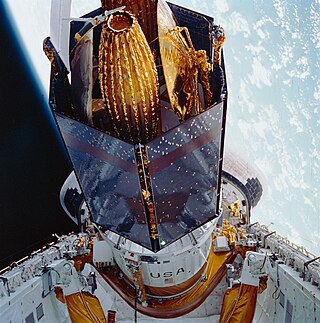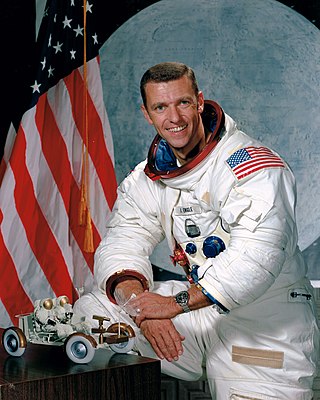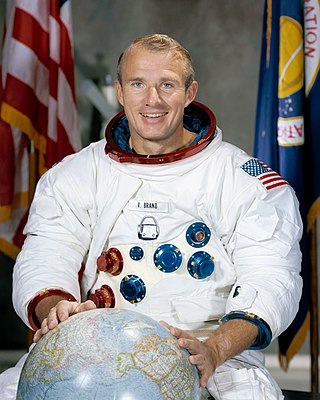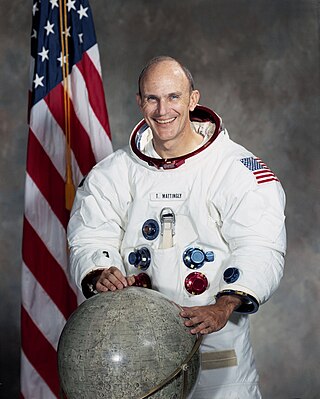Related Research Articles

Michael Phillip Anderson was a United States Air Force officer and NASA astronaut. Anderson and his six fellow crew members were killed in the Space Shuttle Columbia disaster when the craft disintegrated during its re-entry into the Earth's atmosphere. Anderson served as the payload commander and lieutenant colonel in charge of science experiments on the Columbia. Anderson was posthumously awarded the Congressional Space Medal of Honor.

John Watts Young was an American astronaut, naval officer and aviator, test pilot, and aeronautical engineer. He became the 9th person to walk on the Moon as commander of the Apollo 16 mission in 1972. He is the only astronaut to fly on four different classes of spacecraft: Gemini, the Apollo command and service module, the Apollo Lunar Module and the Space Shuttle.

Robert Laurel Crippen is an American retired naval officer and aviator, test pilot, aerospace engineer, and retired astronaut. He traveled into space four times: as pilot of STS-1 in April 1981, the first Space Shuttle mission; and as commander of STS-7 in June 1983, STS-41-C in April 1984, and STS-41-G in October 1984. He was also a part of the Manned Orbiting Laboratory (MOL), Skylab Medical Experiment Altitude Test (SMEAT), ASTP support crew member, and the Approach and Landing Tests (ALT) for the Space Shuttle.

STS-61-C was the 24th mission of NASA's Space Shuttle program, and the seventh mission of Space Shuttle Columbia. It was the first time that Columbia, the first space-rated Space Shuttle orbiter to be constructed, had flown since STS-9. The mission launched from Florida's Kennedy Space Center on January 12, 1986, and landed six days later on January 18, 1986. STS-61-C's seven-person crew included the first Costa Rican-born astronaut, Franklin Chang-Díaz, and 2 future Administrators of NASA: the second African-American shuttle pilot, Charles Bolden, and the second sitting politician to fly in space, Representative Bill Nelson (D-FL). It was the last shuttle mission before the Space Shuttle Challenger disaster, which occurred ten days after STS-61-C's landing.

STS-26 was the 26th NASA Space Shuttle mission and the seventh flight of the orbiter Discovery. The mission launched from Kennedy Space Center, Florida, on September 29, 1988, and landed four days later on October 3, 1988. STS-26 was declared the "Return to Flight" mission, being the first mission after the Space Shuttle Challenger disaster of January 28, 1986. It was the first mission since STS-9 to use the original Space Transportation System (STS) numbering system, the first to have all its crew members wear pressure suits for launch and landing since STS-4, and the first mission with bailout capacity since STS-4. STS-26 was also the first U.S. space mission with an all-veteran crew since Apollo 11, with all of its crew members having flown at least one prior mission.

STS-30 was the 29th NASA Space Shuttle mission and the fourth mission for Space Shuttle Atlantis. It was the fourth shuttle launch since the Challenger disaster and the first shuttle mission since the disaster to have a female astronaut on board. The mission launched from Kennedy Space Center, Florida, on May 4, 1989, and landed four days later on May 8, 1989. During the mission, Atlantis deployed the Venus-bound Magellan probe into orbit.

Henry Warren Hartsfield Jr. was a United States Air Force Colonel and NASA astronaut who logged over 480 hours in space. He was inducted into the United States Astronaut Hall of Fame in 2006.

Karol Joseph "Bo" Bobko was an American aerospace engineer, U.S. Air Force officer, test pilot, and a USAF and NASA astronaut. Bobko was the first graduate of the U.S. Air Force Academy to travel in space and the first person to fly on a space shuttle on three different missions: STS-6, STS-51-D, STS-51-J.

Joe Henry Engle is an American pilot, aeronautical engineer and former NASA astronaut. He was the commander of two Space Shuttle missions including STS-2 in 1981, the program's second orbital flight. He also flew two flights in the Shuttle program's 1977 Approach and Landing Tests. Engle is one of twelve pilots who flew the North American X-15, an experimental spaceplane jointly operated by the Air Force and NASA, and the last surviving test pilot of the aircraft. After Richard H. Truly died in 2024, Engle is now the last surviving crew member of STS-2.

Jack Robert Lousma is an American astronaut, aeronautical engineer, retired United States Marine Corps officer, former naval aviator, NASA astronaut, and politician. He was a member of the second crew, Skylab-3, on the Skylab space station in 1973. In 1982, he commanded STS-3, the third Space Shuttle mission. Lousma was inducted into the United States Astronaut Hall of Fame in 1997. He is the last living crew member of both of his spaceflights.

Vance DeVoe Brand is an American naval officer, aviator, aeronautical engineer, test pilot, and NASA astronaut. He served as command module pilot during the first U.S.-Soviet joint spaceflight in 1975, and as commander of three Space Shuttle missions.

Robert Franklyn "Bob" Overmyer was an American test pilot, naval aviator, aeronautical engineer, physicist, United States Marine Corps officer, and USAF/NASA astronaut. Overmyer was selected by the Air Force as an astronaut for its Manned Orbiting Laboratory in 1966. Upon cancellation of the program in 1969, he became a NASA astronaut and served support crew duties for the Apollo program, Skylab program, and Apollo-Soyuz Test Project. In 1976, he was assigned to the Space Shuttle program and flew as pilot on STS-5 in 1982 and as commander on STS-51-B in 1985. He was selected as a lead investigator into the Space Shuttle Challenger disaster in 1986, retiring from NASA that same year. A decade later, Overmyer died while testing the Cirrus VK-30 homebuilt aircraft.

Richard Oswalt Covey is a retired United States Air Force officer, former NASA astronaut, and a member of the United States Astronaut Hall of Fame.

Claude Nicollier is the first astronaut from Switzerland. He has flown on four Space Shuttle missions. His first spaceflight (STS-46) was in 1992, and his final spaceflight (STS-103) was in 1999. He took part in two servicing missions to the Hubble Space Telescope. During his final spaceflight he participated in a spacewalk, becoming the first European Space Agency astronaut to do so during a Space Shuttle mission. In 2000 he was assigned to the Astronaut Office Extravehicular Activity Branch, while maintaining a position as Lead ESA Astronaut in Houston. Nicollier retired from ESA in April 2007.

Thomas Kenneth Mattingly II was an American aviator, aeronautical engineer, test pilot, rear admiral in the United States Navy, and astronaut who flew on Apollo 16 and Space Shuttle STS-4 and STS-51-C missions.

Robert Joseph "Bob" Cenker is an American aerospace and electrical engineer, aerospace systems consultant, and former astronaut. Cenker worked for 18 years at RCA Astro-Electronics, and its successor company GE Astro Space, on a variety of spacecraft projects. He spent most of his career working on commercial communications satellites, including the Satcom, Spacenet and GStar programs.

Don Leslie Lind was an American scientist, naval officer, aviator, and NASA astronaut. He graduated from the University of Utah with an undergraduate degree in physics in 1953. Following his military service obligation, he earned a PhD in high-energy nuclear physics from the University of California, Berkeley in 1964.

Wendy Barrien Lawrence is a retired United States Navy Captain, an engineer, and former helicopter pilot and NASA astronaut. She was the first female graduate of the United States Naval Academy to fly into space and she has also visited the Russian Space Station Mir. She was a mission specialist on STS-114, the first Space Shuttle flight after the Space Shuttle Columbia disaster. She is married to Cathy Watson, a former NASA scientist.

Soichi Noguchi is a Japanese aeronautical engineer and former JAXA astronaut. His first spaceflight was as a mission specialist aboard STS-114 on 26 July 2005 for NASA's first "return to flight" Space Shuttle mission after the Columbia disaster. He was also in space as part of the Soyuz TMA-17 crew and Expedition 22 to the International Space Station (ISS), returning to Earth on 2 June 2010. He is the sixth Japanese astronaut to fly in space, the fifth to fly on the Space Shuttle, and the first to fly on Crew Dragon.
References
- ↑ Mansfield, Cheryl L. (16 March 2015). "Apollo 1".
- ↑ Warnock, Lynda (19 January 2016). "NASA - STS-51L Mission Profile".
- ↑ Warnock, Lynda. "NASA - STS-107". Archived from the original on 2018-02-06. Retrieved 2016-12-17.
- ↑ ""Light This Candle": The Hours Before Freedom 7". 9 May 2012.